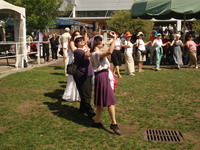The Hora Page
 Dancing Slow Hora/Zhok, Ashkenaz 2008, Watch Video of Slow Hora
Dancing Slow Hora/Zhok, Ashkenaz 2008, Watch Video of Slow Hora
Israeli Hora Videos:
Israeli Hora with Ayalah Goren, daughter of Gurit Kadman, a.k.a. the Mother of Israeli Folk Dance. This dance is different than the more recently choreographed Israeli folk dances that often have the word hora in the title; e.g., Hora Medura, Hora Hadera etc.
Polish Jews 1934, immigrating to Palestine, 7:18 min adults and children on board ship, dancing hora
Dancing the hora on the beach in Tel Aviv (1:30 min mark), 1941
Mir Lebngeblibene at 35:29 minutes features children dancing the hora post-war in Poland.
Modern Hora--Jewish Weddings
What is the Hora? This can be a very confusing question. Here in Canada, if you were to attend a Jewish wedding and the band started to play the song Hava Nagila, people would generally form a circle, and start moving in a counterclockwise direction. Some would be walking, others running, and a large proportion of the dancers would begin to do a grapevine step. At some point the dancers would converge inward, and then back out. Some might choose to dance in the middle, and concentric circles might form. The circle could become a line, with a leader snaking the line around the room. This sort of free form dance, frequently with the grapevine step featured is what Canadian Jews would call the Hora. Stated more simply by Steve Weintraub, "In America, "the hora" is the *generic name for "Jewish dancing." The grapevine step often employed, is called a Mayim step in Israeli folk dancing, because it comes from the Israeli folk dance called Mayim. But there are many other definitions of Hora, in a Jewish and non- Jewish folk dance context, so let's look at a few.
Israeli Hora
To European and North American Jews, prior to the establishment of the state of Israel, the Hora meant the Zionist or Palestinian Hora. This dance became the Israeli Hora. The travelling step in this dance is a 6 beat step which you can see in this historic description circa 1946. It's the well known walk-walk-step-kick-step-kick pattern. Just to keep things interesting, the step employed in the Israeli Hora is actually known as the sarba step in Romanian folk dancing. You can view an archival film of European Jews dancing a Hora at the United States Holocaust Memorial Museum Website. This particular step pattern is the same as the Yiddish Bulgar. For an animated lesson on this hora, visit: http://www.g-dcast.com/horah/
Here is a yizkor book mention of how th hora reached a town in Latvia:
http://www.jewishgen.org/yizkor/Daugavpils/dau39.html
In Memory of the Community of Dvinsk
(Daugavpils, Latvia)
Translation of
Le zekher kehilat Dvinsk
Published in Haifa, 1975
Dvinsk Then and Now
As told by Mr. Aryeh Madelya, Written by Shula Apotker, Grade 8A
In Dvinsk before the war there were many Zionist youth movements, namely: Hashomer Hazair, Gordonia, Herzliya, and Beitar, and also Yiddishist youth movements from the Bund stream. Dvinsk was once an important community. Natan Bistritsky visited there and taught the youth their first Hora. Thus the youth learned to dance the Hora, until he said “Long live Bistritsky and his Hora!”
Within Israeli folk dance, the word Hora is now frequently also attached to specific choreographies that are not anything like the original Israeli Hora. Many people would be familiar with dances like Hora Medura, Hora Nirkoda and the list goes on.
Yiddish Slow Hora/Zhok
However, there is an older Jewish definition of the word Hora that was and is used among klezmer musicians. In that context, the Hora aka Zhok (see video), was and is a slow and stately dance that is performed to a specific rhythm pattern, the slow-quick underlying back-beat. Visit the dance index page to find a detailed view of this dance. According to the late Dick Crum, this version of Hora is based upon a Romanian Hora:
"The so-called "Slow Hora." In Romania the "Slow Hora" (an ad-hoc, informal term used among American researchers of the subject -- no standard "term of art" seems to exist among Romanian dance researchers) is danced to various tunes and under various names, and appears to be limited to Moldavia/Bucovina, possibly to the old upper classes (?). It is usually performed to a relatively slow melody, conventionally notated in 6/8 meter.
Its rhythm is "slow-quick, slow-quick" (2/16-1/16, 2/16-1/16) per measure.
The dance is slow, majestic, almost solemn, in a walking style, with hands joined at shoulder height and held slightly forward, elbows bent gently"
Country Hora
Also in a klezmer context, there is a dance, referred to as Country Hora by Zev Feldman, that is a different version than the Zhok. The music for this type of Hora is not Zhok, but instead a 2 or 4 beat, quick tempo, melody. Watch Video.
Yerushalayimdiker Hora/Hora Yerushalmi
Within the Hasidic community, the current definition of Hora is similar to the Israeli Hora noted above, but is danced in a different style. This dance is taught as the Hasidic Hora by Jill Gellerman in the video Dancing into Marriage, available from Judith Brin Ingber.
Hora in Other Cultures
In addtion to all the Jewish versions of the Hora we've been discussing, we must not forget that in many European languages, the word hora is a generic word for dance. In other words, the Hora is in the eye of the beholder.
I wish to thank Steve Weintraub for his editing of this article and to all who participated in this discussion on the Jewish Music List over Dec 14-18, 2007 and beyond, for adding many points to ponder.
*In the world of Yiddish dance, generic Jewish dancing is called the Freylekhs
Read:
AHAT-RATZON, NAOMI. IS THE HORA AN ISRAELI DANCE. Israel Dance Annual 1977.